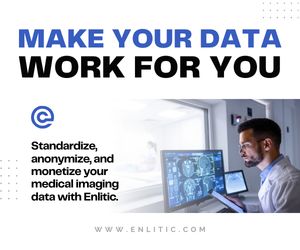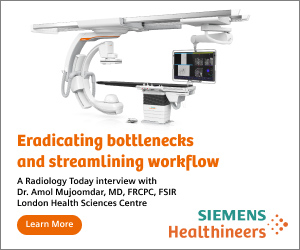|
E-Newsletter • August 2024 |
▼ ADVERTISEMENT
 
Editor's E-Note
DR is the backbone of radiology, but increasing demand for imaging continues to strain workflow. New technologies, particularly AI, offer help for busy radiologists. This month’s E-News Exclusive takes a look at some of the ways AI and other technologies are being used to enhance DR’s capability.
In what ways has AI affected your work? Please let us know on X, formerly known as Twitter, and/or Facebook.
Enjoy the newsletter.
— Dave Yeager, editor |
|
|
|
▼ ADVERTISEMENT
 |
Technological Breakthrough
AI and other technologies help radiologists manage workflow.
Medical imaging is the keystone of modern health care. It enables about 70% of clinical diagnoses and accounts for 80% to 90% of all hospital data. The World Health Organization (WHO) claims that, globally, more than 3.6 billion diagnostic radiology examinations are performed each year.
Globally, there is a significant shortage of radiologists. An alarming fact from the WHO indicates that two-thirds of the globe does not have access to basic radiology services.
▼ ADVERTISEMENT

The availability of radiologists doesn’t seem to be matching the growth rate of the population or the demand for imaging. India, for example, the most populous country in the world, has merely 20,000 radiologists to serve a population of over 1.4 billion. This is an alarming ratio of just one radiologist for every 100,000 individuals, far below many developed and developing countries. Europe has 13 radiologists per 100,000 people. In the United Kingdom, the rate is ~9 per 100,000. While countries such as the United Kingdom and the United States have thousands of radiologists to serve their citizens, some countries in the sub-Saharan Africa region do not have a single radiologist.
The shortage of radiologists has far-reaching consequences for health care systems and patients worldwide. The COVID-19 pandemic exacerbated this crisis, claiming countless lives. Radiology played a pivotal role during the pandemic, placing immense strain on already overburdened radiology departments. Radiologists faced unprecedented workloads, compromising work-life balance and overall well-being.
The major challenges facing the radiology industry today include the following:
- lack of radiologists;
- radiation exposure;
- high patient throughput time; and
- cost.
However, radiology is at the threshold of a revolution with the coupling of DR with new-age technologies, especially AI.
▼ ADVERTISEMENT
 |
AI Model Produces Results Similar to Radiologists on Prostate MRIs
An AI model has been shown to detect prostate cancer on MRIs at a rate on par with radiologists, according to a study published in Radiology.
Cancer Therapy Gets ‘Boosted’ Effectiveness
CAR T cell therapy, which targets and attacks certain cancer cell properties, doesn’t typically work well against nonblood-related cancers. However, a study published in Science Immunology revealed that targeting a different property of cancer cells could make CAR T much more effective.
Pancreatic Lesions Depicted by 3D Model
Utilizing 3D modeling, researchers at Johns Hopkins Kimmel Cancer Center have discovered a way to profile precancerous lesions in the pancreas that can lead to aggressive cancers. The results of their research were published in Nature.
▼ ADVERTISEMENT
 |
“Heart failure is a lethal condition resulting from rising pressures. One of the most significant findings of this study is that MRI-derived pressure measurements can reliably predict if an individual will develop heart failure. This breakthrough suggests that heart MRI could potentially replace invasive diagnostic tests. Participants with higher heart pressure measured by MRI had a fivefold increased risk of developing heart failure over six years.”
— Pankaj Garg, PhD, an associate professor in cardiovascular medicine at the University of East Anglia, honorary consultant cardiologist at Norfolk and Norwich University Hospitals Foundation Trust, and colead author of a study regarding a new MRI technique that can accurately predict heart pressure and assess heart failure risk |
|
|
COVER STORY
Look Again?
Those in the radiology field are considering whether radiology second opinion services, despite their surging popularity, are worthwhile.
FEATURE
The Depths of the Heart
Emerging technologies can provide radiologists with more insight than standard coronary CT into coronary conditions, allowing them to treat disease more effectively.
|
|
|
| Advertising Opportunities |
Have a product or service you want to market to radiology professionals? Utilize the reach of Radiology Today Magazine to accomplish your marketing goals. Email our experienced account executives today at sales@gvpub.com or call 800-278-4400 for more information.
|
| © 2024 Radiology Today Magazine |
|
|